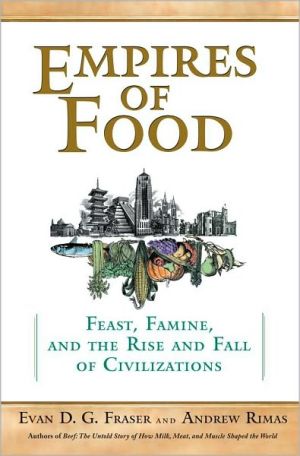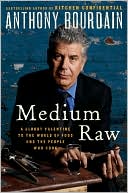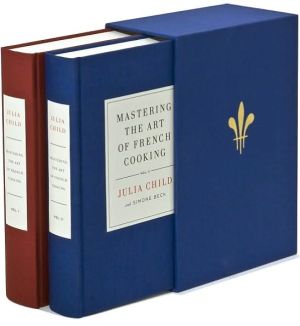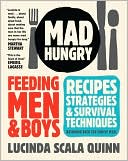Empires of Food: Feast, Famine, and the Rise and Fall of Civilizations
We are what we eat: this aphorism contains a profound truth about civilization, one that has played out on the world historical stage over many millennia of human endeavor. \ Using the colorful diaries of a sixteenth-century merchant as a narrative guide, Empires of Food vividly chronicles the fate of people and societies for the past twelve thousand years through the foods they grew, hunted, traded, and ate—and gives us fascinating, and devastating, insights into what to expect in years to...
Search in google:
We are what we eat: this aphorism contains a profound truth about civilization, one that has played out on the world historical stage over many millennia of human endeavor. Using the colorful diaries of a sixteenth-century merchant as a narrative guide, Empires of Food vividly chronicles the fate of people and societies for the past twelve thousand years through the foods they grew, hunted, traded, and ate—and gives us fascinating, and devastating, insights into what to expect in years to come. In energetic prose, agricultural expert Evan D. G. Fraser and journalist Andrew Rimas tell gripping stories that capture the flavor of places as disparate as ancient Mesopotamia and imperial Britain, taking us from the first city in the once-thriving Fertile Crescent to today’s overworked breadbaskets and rice bowls in the United States and China, showing just what food has meant to humanity. Cities, culture, art, government, and religion are founded on the creation and exchange of food surpluses, complex societies built by shipping corn and wheat and rice up rivers and into the stewpots of history’s generations. But eventually, inevitably, the crops fail, the fields erode, or the temperature drops, and the center of power shifts. Cultures descend into dark ages of poverty, famine, and war. It happened at the end of the Roman Empire, when slave plantations overworked Europe’s and Egypt’s soil and drained its vigor. It happened to the Mayans, who abandoned their great cities during centuries of drought. It happened in the fourteenth century, when medieval societies crashed in famine and plague, and again in the nineteenth century, when catastrophic colonial schemes plunged half the world into a poverty from which it has never recovered. And today, even though we live in an age of astounding agricultural productivity and genetically modified crops, our food supplies are once again in peril. Empires of Food brilliantly recounts the history of cyclic consumption, but it is also the story of the future; of, for example, how a shrimp boat hauling up an empty net in the Mekong Delta could spark a riot in the Caribbean. It tells what happens when a culture or nation runs out of food—and shows us the face of the world turned hungry. The authors argue that neither local food movements nor free market economists will stave off the next crash, and they propose their own solutions. A fascinating, fresh history told through the prism of the dining table, Empires of Food offers a grand scope and a provocative analysis of the world today, indispensable in this time of global warming and food crises. Publishers Weekly The agricultural system that sustains modern society will eventually destroy it, argues this gloomy ecohistory. Leeds University agricultural researcher Fraser and Boston journalist Rimas survey a range of premodern civilizations, including Sumer, Han China, and medieval Europe, to distill the common features that allowed them to feed large urban populations: farming specialization, surpluses, trade, transportation, and food storage. Alas, the authors contend, these “food empires” bred soaring populations, exhausted soils, led to deforestation and erosion, which together with a turn in the climate, led to famine and collapse. They apply this neo-Malthusian lesson to our “cancerous” mega-agriculture, based on artificial fertilizer, fossil fuels, and mono-cropping. The authors' tour of food empires past, framed by an irrelevant narrative of a 16th-century Florentine merchant, is interesting but scattershot. Further, they fail to convince on why technological innovations in agriculture will fail, and lapse into a dubious brief for locavorism. (June 15)
Introduction xi\ Part I The Price of Food 1\ The Three Gorges Dam 3\ The Rise and Fall of Food Empires, Past, Present, and Future 7\ Chapter 1 Fairs: The Food Trade 13\ The Desert Fathers 16\ Work, Pray, Eat 18\ The Agricultural Revolution of A.D. 900 20\ Fayre Is Fair 22\ The Pendulum Swings 28\ The Pendulum Swings Back 32\ Manure from the Bones 37\ Chapter 2 Larders: What Do You Do with Ten Thousand Tons of Grain? 41\ National Security and a War on Terror 43\ Bread Alone 46\ Not by Bread Alone: Oil and Fish 49\ Hannibal Lectured 52\ A Question of Logistics 57\ Grounds for Exhaustion 59\ How to Feed an Empire, Cheap 62\ The Larder Is Empty 64\ Chapter 3 Farms: Growing Food for Profit and Environmental Rapine 69\ The Grapes of Wrath 72\ God in the Cup 79\ The Weak Heart of Today's Food Empire 86\ Part II The Price Rises 91\ An Experiment in Survival 93\ Chicken Little or a Lot of Chicken? 97\ Chapter 4 Water: Irrigations Questionable Cure 101\ Mesopotamia's Fix 104\ In Praise of Grain 107\ Oriental Despotism 110\ Retreat of the Elephants 115\ The Yellowing River 118\ Water, Water Everywhere? 121\ Chapter 5 Dirt: The Chemistry of Life 125\ The Story of N 126\ In Praise of Phytoplankton 129\ Fecal Politics 131\ War Empires 136\ The Birds of Peru 141\ Chapter 6 Ice: Preserve Us 145\ How Food Rots and How to Slow It Down 146\ It's a Jungle 150\ The Industrial Garden State 152\ Triumph of the Tomato 156\ California Scheming 159\ The Orange Juice Quandary 161\ Part III Empty Pockets 165\ Storm Clouds 167\ Chapter 7 Blood: The Conquest of Food 173\ Rebellion in the Spice Islands 179\ Chiapas 183\ The Moral Economy of Food 187\ The Climate Trigger 193\ Chapter 8 Money: Tea and Famine 197\ A Foundation in Pirates 199\ Victorian High Tea 203\ Her Majesty's Drug Cartel 205\ "In America, There Could Be No Famine…" 209\ The Great Hunger 211\ The Food Empires Ahead 214\ Chapter 9 Time: Fair, Organic, and Slow 219\ The Meaning of Fairness 222\ Greener Pastures 230\ The Snail Triumphant 235\ Conclusion: The New Gluttony and Tomorrow's Menu 243\ Acknowledgments 255\ Notes 257\ Index 289
\ Publishers WeeklyThe agricultural system that sustains modern society will eventually destroy it, argues this gloomy ecohistory. Leeds University agricultural researcher Fraser and Boston journalist Rimas survey a range of premodern civilizations, including Sumer, Han China, and medieval Europe, to distill the common features that allowed them to feed large urban populations: farming specialization, surpluses, trade, transportation, and food storage. Alas, the authors contend, these “food empires” bred soaring populations, exhausted soils, led to deforestation and erosion, which together with a turn in the climate, led to famine and collapse. They apply this neo-Malthusian lesson to our “cancerous” mega-agriculture, based on artificial fertilizer, fossil fuels, and mono-cropping. The authors' tour of food empires past, framed by an irrelevant narrative of a 16th-century Florentine merchant, is interesting but scattershot. Further, they fail to convince on why technological innovations in agriculture will fail, and lapse into a dubious brief for locavorism. (June 15)\ \ \ \ \ Kirkus ReviewsA panoramic overview of the vulnerability of global food networks to climate change. In a follow-up to their previous collaboration, Beef: The Untold Story of How Milk, Meat, and Muscle Shaped the World (2008), Fraser (Environmental Studies/Leeds Univ.) and Improper Bostonian managing editor Rimas draw important lessons from the past to inform their study. "For 8000 years, food empires have expanded as far as transport and topsoil and market would allow," they write, only to collapse when faced with the effects of inevitable climate shifts exacerbated by erosion, the deterioration of irrigation systems and the failure to maintain adequate storage facilities. Their message is stark: "A sustainable food empire can only exist if most of its farms are smallish, diverse and serving customers not too far away." The shift from hunter-gatherer to agricultural societies helped create the emergence of large-scale farming of a few cash crops and laid the foundation for the expansion of major empires. Food became a commodity and only profit counted. In today's global economy, "urbanites around the world rely on just a handful of crops-wheat, maize, rice, and soy-to provide the majority of our nutrition," and these are usually grown in just a few primary areas ("Ukraine, the Great Plains and China's river valleys") Overuse of fertilizers and pesticides threaten productivity, and if oil supplies disappear, fertilizer will become unavailable and "[t]hree billion people would lose their daily sustenance." A two-degree rise in temperature would also bring the specter of mass famine despite "all [our] technological talent." Though the topic is serious, the authors provide plenty of enlightening stories,including the adventures of a 16th-century Italian merchant who spent 15 years circumnavigating the globe, and the work of St. Benedict of Nursia, who established a network of monasteries that became "a nucleus of industry and food production," producing agricultural surpluses, creating commercial networks and promoting technological advances such as iron plows and the use of oxen. Spanning the whole of human civilization, this is a compelling read for foodies, environmentalists and social and economic historians.\ \








